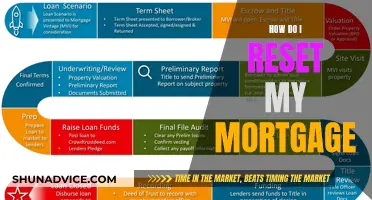
A mortgage payoff letter is a crucial document in the mortgage repayment process. It serves as a formal record of the date and amount repaid, contact information, and other terms of the payoff. This letter can be requested by borrowers to learn about their remaining principal amount and interest. It also includes information such as where to send the money and how long the payoff estimate is valid. This letter can be used by borrowers to pay off the remaining balance or provided to the title company during the closing process of a home sale. It is a legally binding document that protects both the borrower and the lender from potential disputes and confusion.
What You'll Learn

The purpose of a mortgage payoff letter
A mortgage payoff letter is a formal document that outlines the remaining principal amount and interest that borrowers must pay to close out their loan. It also includes other key information, such as where to send the money, what payoff forms are acceptable, and how long the payoff estimate is valid for (given interest costs). This letter can be used by borrowers to pay off the remaining balance themselves or provided to a title company as part of the closing process for their home sale.
The first type of mortgage payoff letter informs borrowers of the remaining principal amount and interest they must pay to close their loan. This letter is typically requested by borrowers who want to know the exact amount needed to pay off their mortgage. It includes information such as the outstanding principal balance, accrued interest, and any additional charges that have accrued since the last statement.
The second type of mortgage payoff letter confirms that the borrower has fulfilled all payment obligations. This letter can also signify that the borrower has achieved a clean title to the property. This type of letter is often provided by the lender after the loan has been paid off in full, serving as a legally binding document acknowledging that the debt has been settled.
A mortgage payoff letter is an essential aspect of the loan or mortgage repayment process. It serves as a formal record of the repayment details, including the date, amount, contact information for all relevant parties, and any additional terms or conditions of the payoff. This document protects both borrowers and lenders from potential disputes or confusion by ensuring that all parties are aware of and agree to the terms outlined.
Exploring Options: Strategies to Temporarily Pause Mortgage Payments
You may want to see also

How to request a mortgage payoff letter
A mortgage payoff letter is a crucial document that outlines the remaining principal amount and interest that borrowers need to pay to close out their loan. This letter also includes other key details, such as where to send the money, acceptable payoff forms, and the validity period of the payoff estimate. It is a formal document that borrowers can use to pay off their remaining balance or provide to a title company during the closing process of a home sale.
To request a mortgage payoff letter, follow these steps:
Contact Your Lender
Reach out to your lender or loan servicer to express your intention to obtain a mortgage payoff statement. This can be done online, in person at a banking location, or by contacting a customer service representative. You may be required to provide personal information, such as your name, contact details, and loan account number, to initiate the request process.
Provide Relevant Information
When requesting the payoff letter, ensure you include comprehensive and accurate information about your loan. This includes the outstanding principal balance, any accrued interest, late charges or fees, and other additional charges. It is important to be clear and provide specific details to ensure a smooth process.
Understand the Process and Timing
Obtaining a mortgage payoff statement can take some time, and there are important dates to consider. You will need to choose a good-through date, which is when your payoff must be received to cover your remaining loan balance. If you do not pay off your mortgage by this date, you will need to request an updated quote. Lenders typically have a specified timeframe within which they must provide the payoff statement, which may be within 7 business days of the initial request.
Verify and Confirm Receipt
After submitting your request, verify the account number and address to send the final payment. Ask your lender to provide written confirmation of the receipt of your request and the finalized payoff amount. This ensures that you have the most accurate and up-to-date payment information.
By following these steps, you can effectively request a mortgage payoff letter and gather the necessary information to understand your loan obligations and make informed decisions about paying off your mortgage.
Strategies to Remove Private Mortgage Insurance from Your Home Loan
You may want to see also

What information to include in a mortgage payoff letter
A mortgage payoff letter is a formal document that records the date and amount of the repayment, contact information for the lender and borrower, and additional terms or conditions of the payoff. It serves as a legally binding document that protects both the borrower and the lender from potential disputes or confusion regarding the repayment. Here is the information to include in a mortgage payoff letter:
Contact Information
Include the contact information of all relevant parties, such as the lender, borrower, and any other parties involved. This includes names, addresses, and phone numbers, and email addresses.
Loan Details
Provide comprehensive and accurate details regarding the loan, including the outstanding principal balance, accrued interest, late charges or fees, and any other additional charges that have accrued since the last statement.
Payment Information
Mention the expected date of receipt for payment and the payment method, such as a check or electronic transfer. Also, include any relevant account numbers or addresses to send the final payment to.
Additional Terms and Conditions
Outline any additional terms or conditions related to the repayment. This could include early payment penalties, fees for account closing, or any other relevant information.
Signatures
Finally, include signatures from both the borrower and the lender, attesting to their agreement with the terms outlined in the letter.
It is important to double-check the accuracy of the information in the payoff letter to ensure a smooth process and protect both parties from potential issues or disputes.
Removing an Ex-Spouse from a Joint Mortgage
You may want to see also

The legal implications of a mortgage payoff letter
A mortgage payoff letter is a crucial document in the mortgage repayment process, serving as a formal record of the repayment details and protecting both the borrower and lender. The letter outlines the remaining principal amount, accrued interest, and any additional fees or charges that the borrower must pay to close out the loan. This letter also includes information such as where to send the money, acceptable payment methods and forms, and the duration of the payoff estimate's validity.
From a legal standpoint, the mortgage payoff letter is a binding document that provides protection and clarity to both the borrower and the lender. It serves as evidence of the repayment, outlining the date, amount, and any other relevant terms and conditions agreed upon. This letter can prevent potential disputes or confusion, as all parties are aware of the terms and can refer to them if needed. Additionally, the letter helps protect against further claims or liability once the debt is settled. It acts as a formal acknowledgment from the lender that the debt has been paid in full, reducing the risk of future complications.
To ensure the legal effectiveness of the mortgage payoff letter, several key components must be included. Firstly, the letter should contain accurate and up-to-date payment information, including the outstanding principal balance, interest, and any additional charges. Secondly, it should provide clear and concise details regarding the loan, such as the loan account number, relevant dates and deadlines, and the borrower's contact information. Thirdly, the letter should specify the payment method, such as a cheque or electronic transfer, to ensure proper fund disbursement.
Furthermore, signatures from both the borrower and the lender are essential to attest to their agreement with the terms outlined in the letter. This mutual agreement is a critical aspect of the legal implications of the document. It is also beneficial to request written confirmation of receipt of the letter and the finalized payoff amount from the lender. This additional step provides further assurance and helps prevent potential issues or discrepancies.
In summary, a mortgage payoff letter is a legally binding document that plays a vital role in the mortgage repayment process. It protects both parties by providing a formal record of the repayment details, preventing disputes, and reducing the risk of future claims. By including essential information and obtaining mutual agreement, the letter ensures a clear understanding of the repayment obligations and facilitates a smooth and efficient process for all involved parties.
Understanding Mortgage Debt: Strategies for Homeowners
You may want to see also

The different types of mortgage payoff letters
A mortgage payoff letter is a document provided by a lender that outlines the total amount owed on a loan. It is a legally binding document that acknowledges that the borrower's debt has been settled. There are two types of mortgage payoff letters:
The first type of mortgage payoff letter
This type of letter tells borrowers the remaining principal amount and interest they have to pay to close out the loan. This formal letter also includes other key information, such as where to send the money, what payoff forms are acceptable, and how long the payoff estimate is valid for (given interest costs). Borrowers can then use this letter to pay off the remaining balance themselves or provide it to their title company as part of the closing process for their home sale.
The second type of mortgage payoff letter
This type of letter confirms that the borrower has fulfilled their payment obligation. This letter can also signify the achievement of a clean title to the property in the name of the borrower. It is important to note that requesting a mortgage payoff letter does not initiate any formal processes and can be considered an information-gathering exercise.
It is worth mentioning that mortgage payoff letters are not the only way to learn about your current loan balance. You can also request a verbal payoff quote from your lender, which will provide you with an estimate of the amount you need to pay off your loan. However, any quote given verbally is not official or legally binding, and there is a risk of inaccuracy.
Signing Off: Phh Mortgage Web Page Guide
You may want to see also
Frequently asked questions
A mortgage payoff letter is a document provided by a lender that outlines the total amount owed on a loan. It can come in two forms. The first tells borrowers the remaining principal amount and interest they have to pay to close out the loan, along with other key information such as where to send the money and what payoff forms are acceptable. The second type confirms that the borrower has no further obligation for payment and signifies the achievement of a clean title to the property in the borrower's name.
A mortgage payoff letter should include key information such as contact information for all relevant parties, details of the mortgage, the expected date of receipt for payment, any additional terms or conditions related to repayment, and signatures from both borrower and lender. It is important to double-check the accuracy of the information in the letter.
To obtain a mortgage payoff letter, you will need to contact your lender and request the information. You may be required to supply some personal information and explain why you are choosing an early payoff. The lender may charge a small fee for providing the payoff letter.







